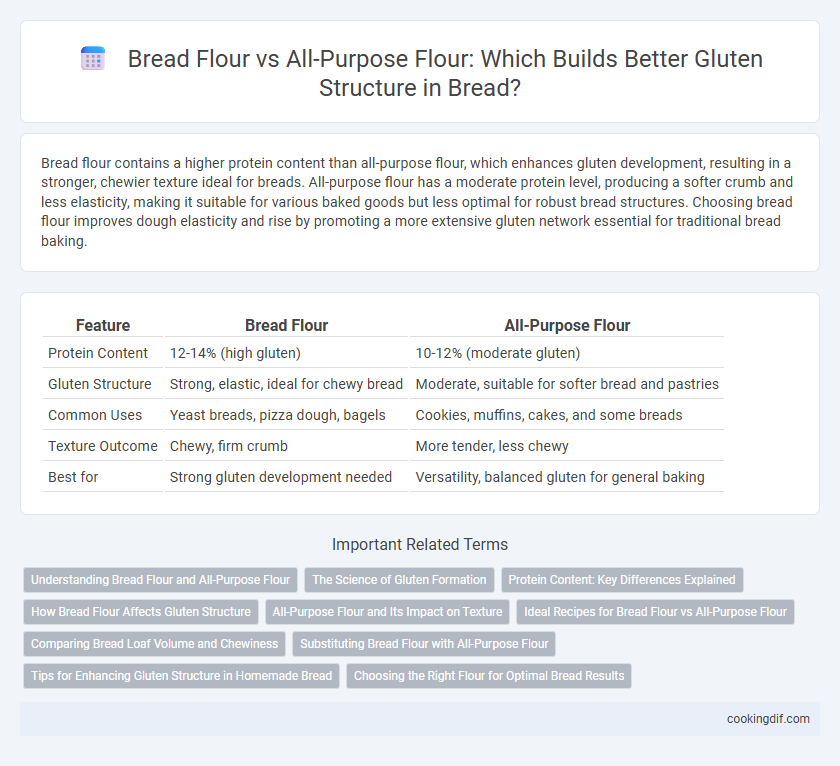Bread flour contains a higher protein content than all-purpose flour, which enhances gluten development, resulting in a stronger, chewier texture ideal for breads. All-purpose flour has a moderate protein level, producing a softer crumb and less elasticity, making it suitable for various baked goods but less optimal for robust bread structures. Choosing bread flour improves dough elasticity and rise by promoting a more extensive gluten network essential for traditional bread baking.
Table of Comparison
| Feature | Bread Flour | All-Purpose Flour |
|---|---|---|
| Protein Content | 12-14% (high gluten) | 10-12% (moderate gluten) |
| Gluten Structure | Strong, elastic, ideal for chewy bread | Moderate, suitable for softer bread and pastries |
| Common Uses | Yeast breads, pizza dough, bagels | Cookies, muffins, cakes, and some breads |
| Texture Outcome | Chewy, firm crumb | More tender, less chewy |
| Best for | Strong gluten development needed | Versatility, balanced gluten for general baking |
Understanding Bread Flour and All-Purpose Flour
Bread flour contains a higher protein content, typically around 12-14%, which strengthens gluten development and gives bread its chewy texture and firm structure. All-purpose flour has a moderate protein level, usually 10-12%, resulting in a softer crumb and tender baked goods but less elasticity and rise in bread. Understanding the protein differences between bread flour and all-purpose flour is essential for achieving the desired gluten network and texture in various bread recipes.
The Science of Gluten Formation
Bread flour contains higher protein content, typically around 12-14%, which enhances gluten formation and provides the dough with greater elasticity and strength. This increased gluten development allows bread to rise better and achieve a chewier texture, ideal for artisan and yeast-leavened breads. All-purpose flour has lower protein levels, around 10-12%, resulting in less gluten and a softer crumb structure, making it more suitable for cakes and pastries rather than bread requiring a strong gluten network.
Protein Content: Key Differences Explained
Bread flour contains a higher protein content, typically around 12-14%, which enhances gluten development and results in a chewier, more elastic texture ideal for yeast breads. All-purpose flour has a lower protein content, generally between 9-12%, producing a softer crumb and less gluten strength suitable for cakes and cookies. Selecting bread flour or all-purpose flour significantly impacts the dough's rise, structure, and final bread texture due to these protein differences.
How Bread Flour Affects Gluten Structure
Bread flour contains higher protein content, typically 12-14%, which promotes stronger gluten network formation essential for bread's chewy texture. This enhanced gluten structure traps carbon dioxide during fermentation, resulting in better rise and improved crumb elasticity. In contrast, all-purpose flour's lower protein content yields weaker gluten development, making bread flour the preferred choice for artisanal loaves requiring superior structure and volume.
All-Purpose Flour and Its Impact on Texture
All-purpose flour contains moderate protein levels, typically 10-12%, which contributes to a balanced gluten structure suitable for softer bread textures. Its gluten development results in a tender crumb rather than the chewier, denser texture produced by bread flour's higher protein content. This flour type enables versatility in baking, producing bread with a fine, light texture preferred for sandwich loaves and softer crusts.
Ideal Recipes for Bread Flour vs All-Purpose Flour
Bread flour contains a higher protein content, typically 12-14%, which enhances gluten development, making it ideal for recipes requiring strong structure like artisanal loaves and pizza dough. All-purpose flour has a moderate protein level around 10-12%, suitable for softer breads, quick breads, and muffins where a tender crumb is preferred. Using bread flour results in chewier texture and better rise, while all-purpose flour is versatile for everyday baking with a lighter texture.
Comparing Bread Loaf Volume and Chewiness
Bread flour contains higher protein content, typically 12-14%, which enhances gluten development resulting in greater loaf volume and a chewier texture. All-purpose flour has lower protein, around 10-12%, producing a softer crumb and less elastic gluten structure, leading to a denser loaf with reduced chewiness. Choosing bread flour improves the rise and firmness essential for artisanal bread, while all-purpose flour suits softer, less chewy baked goods.
Substituting Bread Flour with All-Purpose Flour
Substituting bread flour with all-purpose flour reduces gluten strength due to its lower protein content, which may result in a less elastic dough with weaker structure. Bread flour contains approximately 12-14% protein, essential for developing the strong gluten network needed for chewy, airy bread textures. Bakers seeking similar gluten development when using all-purpose flour (typically 10-12% protein) may need to adjust hydration or incorporate vital wheat gluten to improve dough elasticity and rise.
Tips for Enhancing Gluten Structure in Homemade Bread
Bread flour contains higher protein content, typically 12-14%, which develops stronger gluten networks essential for chewy, structured homemade bread. When using all-purpose flour with lower protein (around 10-12%), combine it with vital wheat gluten or increase kneading time to improve gluten elasticity. Proper hydration levels, resting dough during bulk fermentation, and incorporating stretch-and-fold techniques further enhance gluten development for optimal bread texture.
Choosing the Right Flour for Optimal Bread Results
Bread flour, with its higher protein content of 12-14%, creates a stronger gluten network crucial for chewy and elastic bread texture. All-purpose flour contains 10-12% protein, resulting in a less robust gluten structure, suitable for softer, less chewy baked goods. Selecting bread flour enhances dough elasticity and rise, optimizing bread volume and crumb structure for artisanal and rustic loaves.
Bread Flour vs All-Purpose Flour for gluten structure Infographic

 cookingdif.com
cookingdif.com